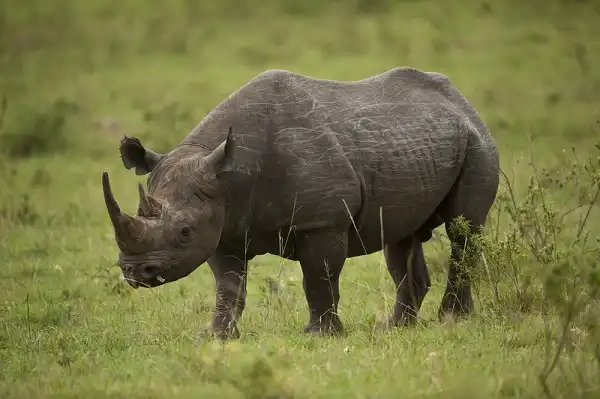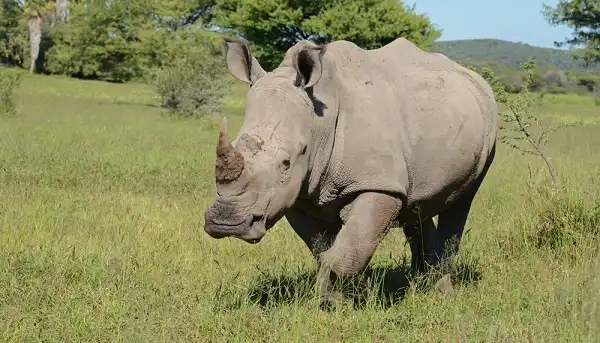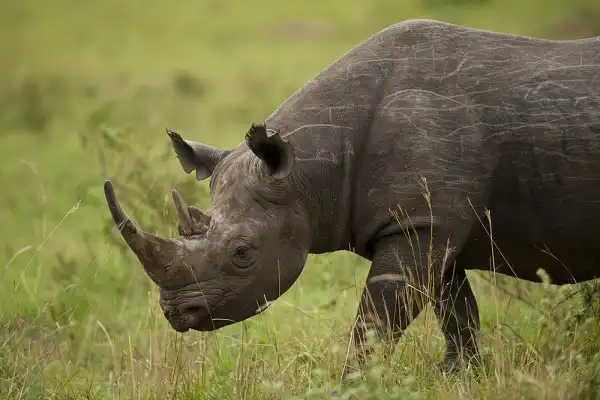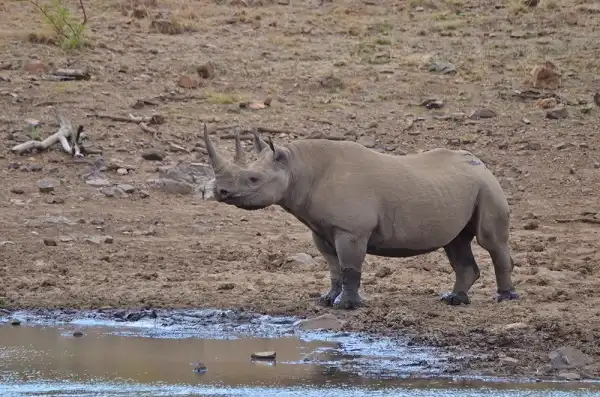The mighty black rhinoceros is a part of African wildlife that’s truly iconic. Not only are they an awe-inspiring sight to behold, but the species provides essential environmental services by eating plants and trees and enabling seed dispersal, which helps maintain biodiversity in its habitat. Unfortunately, this majestic creature is also endangered due to poaching for its horn, leaving us with dwindling numbers of fewer than 5000 individuals left in the wild today. In our post today we will explore why the black rhino needs our help and what measures can be taken to ensure their survival as well as information on their behavior and habitats. Read on to find out more about this remarkable animal!

Black Rhinoceros Description
The black rhinoceros is a species of African rhinoceros native to the continent’s grasslands, woodlands, and savannas. It is characterized by its distinctive long, pointed upper lip and two horns on the front of its face. The larger horn, which can measure up to 60cm in length, is composed of keratin; the smaller one is sometimes absent. Its hide has a grey color that ranges from dark grey to almost black.
Black Rhinoceros Habitat
The black rhinoceros is native to the grasslands, woodlands, and savannas of Africa. They are typically found in areas with dense cover such as thickets and forest edges. In more arid areas they inhabit rocky outcrops, dune fields, and river banks. The black rhino prefers habitats with a wide variety of vegetation that provides them with enough food and cover from potential predators. It typically avoids open plains and lowland valleys but can venture into them during dry periods in search of water. In recent decades, human activities have had a major impact on the habitat of the black rhinoceros. Their natural grassland habitats have been converted for agriculture use which has reduced their available space significantly. Poaching has also become an increasingly serious threat due to the lucrative market for its horns which are used for traditional medicine or as dagger handles in some parts of Asia – this has decreased their population numbers by 97% since 1960 alone!
Black Rhinoceros Diet
The black rhinoceros has an herbivorous diet that mostly consists of leaves, twigs, and branches. They also feed on other vegetation such as fruits, bamboo shoots, and mushrooms depending on the area. Additionally, they may also consume insects as a source of extra nutrition. Black rhinos have poor vision but an excellent sense of smell which helps them detect food sources as well as potential predators from far away. They are well-adapted to living in areas with dense cover such as thickets and forest edges, although they may venture into open plains or lowland valleys in search of water during dry periods. As social animals, they often form small groups consisting of cows (female) with calves or bulls (male). The black rhino’s diet is essential for its survival; it needs to be able to find enough edible plants and vegetation in order to meet its energy requirements. The species is known for being picky eaters which means that they can easily become nutritionally depleted if their food choices are limited due to habitat destruction or lack of diversity in available vegetation.

Black Rhinoceros Size
The black rhinoceros is a large mammal, typically between 1 and 1.4 meters tall and 3-3.8 meters long, with males being larger than females. Depending on age and gender, they can weigh anywhere from 800 to 1400 kilograms. They have an unmistakable look with their distinctive long, pointed upper lip and two horns on the front of their face – the larger horn can grow up to 60 cm in length while the smaller one may be absent at times. Their hide has a grey color that ranges from dark grey to almost black. Their size is advantageous for many reasons, including protection from predators by way of their sheer mass and formidable horns.
Black Rhinoceros Lifespan
The black rhinoceros has an average lifespan of between 35 and 50 years, depending on the habitat and environment. In captivity, they are known to live longer than in the wild since they have access to better resources such as food, water, and medical care when needed. The average age of sexual maturity is between 4-7 years for females and 7-10 years for males. Once a female reaches maturity she can go on to produce around 5 calves over her lifetime – each one spaced 2-3 years apart. Generally speaking, the larger the herd size – the more likely it is that calves will survive due to increased protection from predators. Although black rhinos are long-lived animals, their populations have been drastically reduced due to illegal poaching and habitat destruction caused by human activities such as agricultural expansion into grassland habitats.
Black Rhinoceros Behavior
The black rhinoceros is a highly social creature that can form herds of up to 15 individuals. Females tend to dominate the herd, with the oldest female leading the group and making important decisions such as when or where to move. Bulls (males) typically join the herd only for breeding purposes and will leave again afterward. Black rhinos are mostly active during the night and in the early morning before sunrise, taking time throughout the day for rest and grooming. During this time they also perform interesting behaviors such as mud wallowing where they roll around in mud pits to keep cool in hot climates. They may also engage in ‘shoulder stands’, which involve standing on their hind legs with their front feet resting on a tree trunk or bush – believed to be done as a form of communication between herd members. When threatened by another animal or potential predator such as a lion, black rhinos have been known to aggressively attack by charging and using their horns to inflict damage – this behavior is usually reserved for male bulls, however, females may also use it if they feel threatened enough.

Black Rhinoceros Speed
The black rhinoceros is surprisingly fast for its size, being able to reach speeds of up to 40km/h when running! This impressive speed allows the species to quickly escape potential predators or threats, as well as traverse long distances in search of food and water sources during dry periods. On average, they can maintain a speed of around 10km/h while trotting which is still quite fast considering their large body size. The black rhino has incredibly strong leg muscles that allow them to reach higher speeds than other equally-sized animals, such as elephants. This strength also serves them well in defending themselves against potential predators with their formidable horns. Their legs and hooves are also adapted to enable them to maneuver between dense vegetation and uneven terrain with relative ease – further aiding their escape from danger.
Black Rhinoceros Hunting
Black rhinos are highly sought after by poachers due to their horns, which can fetch a high price on the illegal wildlife trade market. In some cases, poaching is done for traditional medicinal purposes, as the horn is thought to contain healing properties – although this has been scientifically disproved. Other times they are killed for their meat or even trophy hunting, where wealthy individuals pay to hunt them for sport. Sadly, poaching is taking an immense toll on black rhino populations across Africa and other parts of the world where they exist. Fewer than 5,500 wild rhinos remain in Africa today and without better anti-poaching measures in place- it’s likely these numbers will continue to decline. To combat this illegal activity, conservation efforts must focus on increasing anti-poaching measures and educating local communities about the importance of protecting wildlife so that they may have an alternate source of income from sustainable tourism instead of poaching animals. Governments also need to increase funding for law enforcement agencies so that there are more resources available for the investigation and prosecution of those caught participating in the illegal wildlife trade.
Black Rhinoceros Reproduction
Black rhinoceros reproduction typically occurs during the wet season when food is more abundant and conditions are more favorable. Females become sexually mature at around 5-7 years of age and males at around 6-8 years. During mating, they will perform courtship behaviors such as sniffing and licking each other to signal their readiness. After copulation, the female will carry the offspring for a gestation period of 16-18 months before giving birth to a single calf. The newborn calf will stay with its mother for 2-4 years while it learns important skills such as feeding and avoiding potential predators – this is known as ‘alloparental care’. Calves grow quickly in the first 3 months after birth, gaining up to 10kg in weight each month!

Conclusion
The black rhinoceros is an impressive species with several unique attributes – from its powerful legs that enable it to reach speeds of up to 40km/h when running, to its formidable horns used for communication and self-defense. Sadly, illegal poaching and habitat destruction has taken an immense toll on this species and their numbers have been greatly reduced as a result. It is essential that conservation efforts focus on protecting existing habitats while also increasing anti-poaching measures so these majestic creatures can continue living freely without fear of poachers or other threats to their existence – only then can we hope for this species’ continued survival in the wild.
Frequently Asked Question


